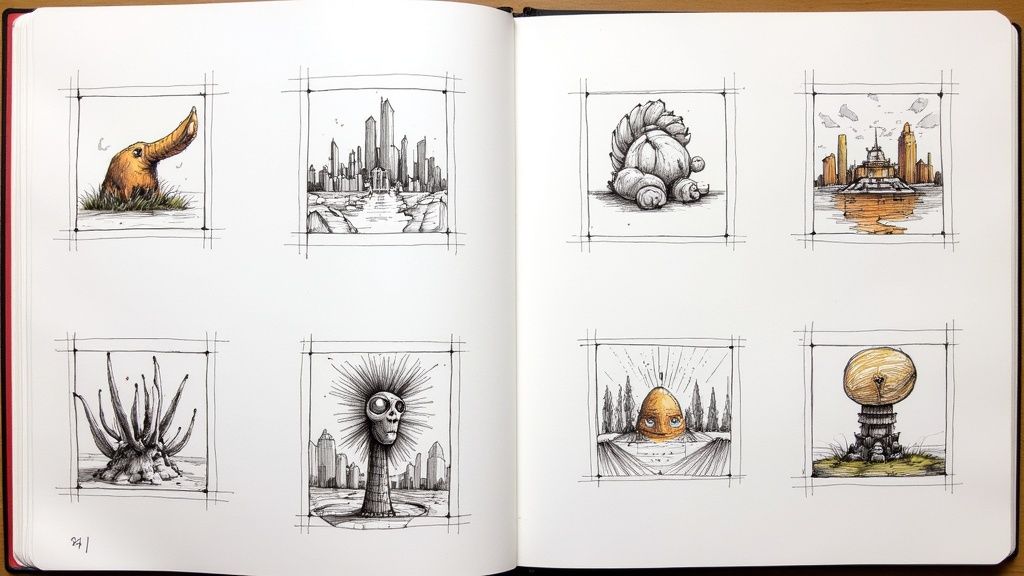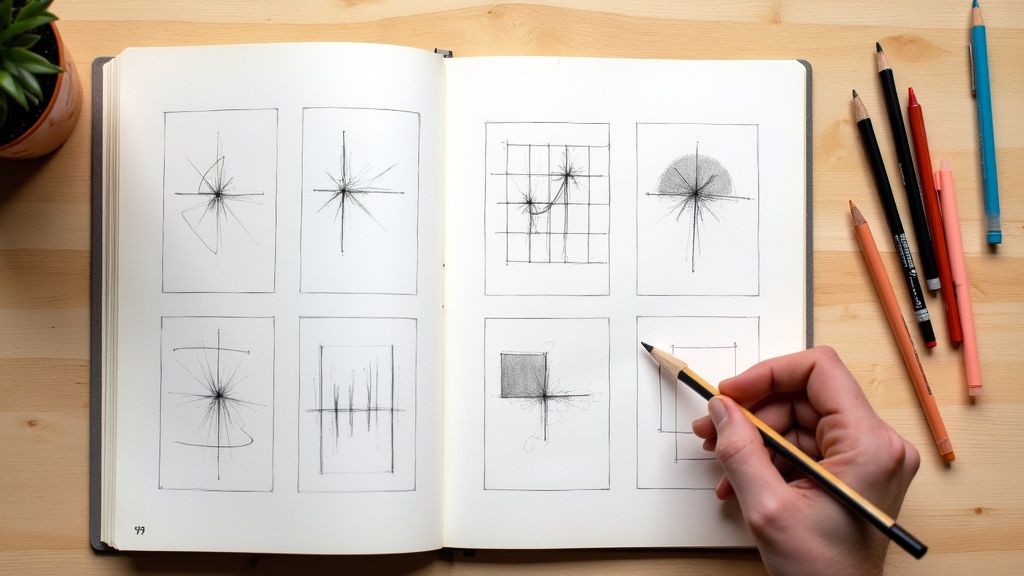Beyond the Blank Page: Reimagining Character Creation
Staring at a blank canvas can be the most intimidating part of the artistic process. The pressure to create something new and compelling often leads to a creative freeze, especially in character design, where every line and shape tells a silent story. The key to breaking this barrier isn't just forcing a pencil to move; it's about having the right spark, a specific question to answer visually. This guide moves beyond generic suggestions, offering a comprehensive collection of structured character drawing prompts to ignite your imagination.
This article provides a deep dive into eight distinct frameworks for character creation. We will explore how to build figures from the inside out, starting with core personality traits, grounding them in specific occupations, or even adapting their physiology to extreme environments. Each category is designed as a complete methodology, offering a unique lens through which to approach your art. You will learn practical techniques to translate abstract concepts, like emotions or historical periods, into tangible, believable designs.
For each of the eight core prompt types, we will provide:
- Actionable steps to guide your process from initial concept to a polished sketch.
- Specific examples to illustrate how these principles are applied in professional work.
- Unique idea lists to give you immediate starting points for your own characters.
Whether you're a seasoned illustrator looking to challenge your habits or a hobbyist seeking to fill a sketchbook, these character drawing prompts will equip you with fresh perspectives. Prepare to transform your approach and discover the countless characters waiting to be drawn.
1. Character Design from Personality Traits: Drawing from the Inside Out
This foundational approach is one of the most powerful character drawing prompts because it forces you to become a visual storyteller. Instead of starting with a cool outfit or a striking face, you begin with the character’s core being: their personality. The central task is to translate abstract psychological traits into tangible visual elements. Every line, shape, and color choice becomes a deliberate reflection of who the character is on the inside, creating a design that feels authentic and resonant.
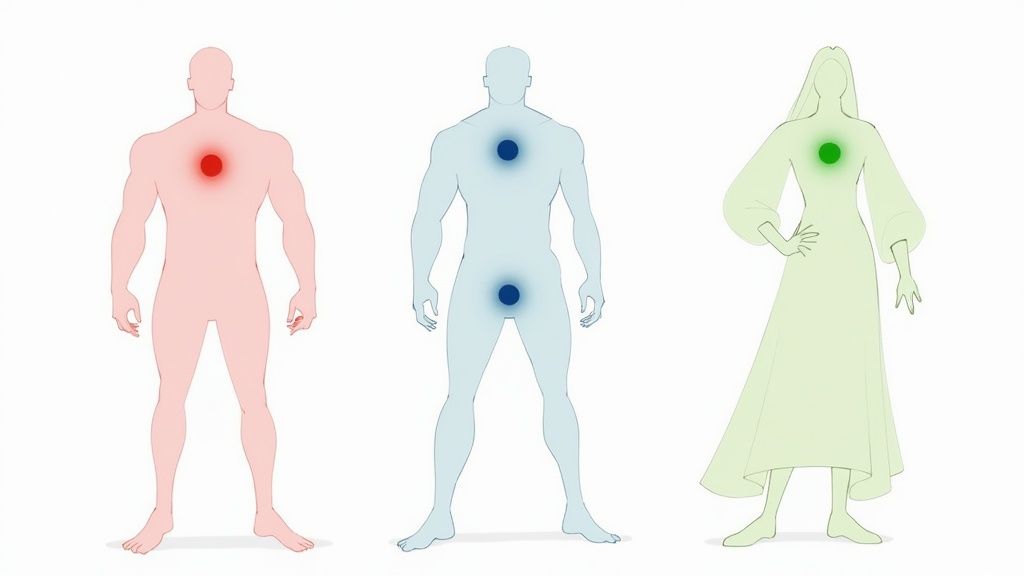
This method, championed by legendary animators like Glen Keane and Hayao Miyazaki, ensures that a character’s appearance communicates their nature before they ever speak. The challenge lies in answering questions like, "What does 'courageous but insecure' look like?" It’s about building a visual thesis for the character, guaranteeing that their design is inherently story-driven and not just a collection of aesthetic choices.
How to Implement This Prompt
Start by selecting three distinct personality traits. For example, let's use jovial, anxious, and meticulous. The next step is to brainstorm the visual language for each trait individually before blending them.
- Jovial: Think in terms of soft, rounded shapes, an open and relaxed posture, and a warm, vibrant color palette. Their clothes might be comfortable and slightly rumpled, and their expression is naturally upturned.
- Anxious: This trait translates into sharp, angular, or broken lines. A hunched posture, fidgeting hands, and a muted, cool color scheme can visually represent unease.
- Meticulous: Express this through details like perfectly pressed clothes, neatly styled hair, and organized accessories. The lines in your drawing might be clean, precise, and controlled.
The real artistry is in the synthesis. How do these traits coexist in one person? Perhaps your jovial character’s smile doesn’t quite reach their anxious eyes. Maybe their meticulous attire is contradicted by a nervously bouncing leg. This interplay of visual cues is what creates a complex, believable character rather than a flat caricature.
Why This Method Works
This "inside-out" approach is incredibly effective for creating characters that connect with an audience on an emotional level.
- Creates Authenticity: When a character's design logically stems from their personality, they feel more real and grounded.
- Enhances Storytelling: The design itself becomes a narrative tool, providing clues about the character’s backstory, internal conflicts, and potential journey. A prime example is Elsa from Disney's Frozen, whose tightly-bound, restrictive clothing and pale color scheme at the beginning of the film perfectly mirror her repressed, fearful state.
- Boosts Creativity: By imposing the constraint of personality, you are pushed to think more creatively about shape language, posture, and clothing, moving beyond generic tropes.
2. Occupation-Based Character Creation
This practical prompt challenges you to build a character outward from their profession. A person's job profoundly influences their daily life, from their physique and posture to their clothing and the tools they carry. Using an occupation as a starting point provides a rich, tangible foundation for your design, making it one of the most effective character drawing prompts for creating grounded and believable figures. The core task is to research a profession and translate its realities into compelling visual details.
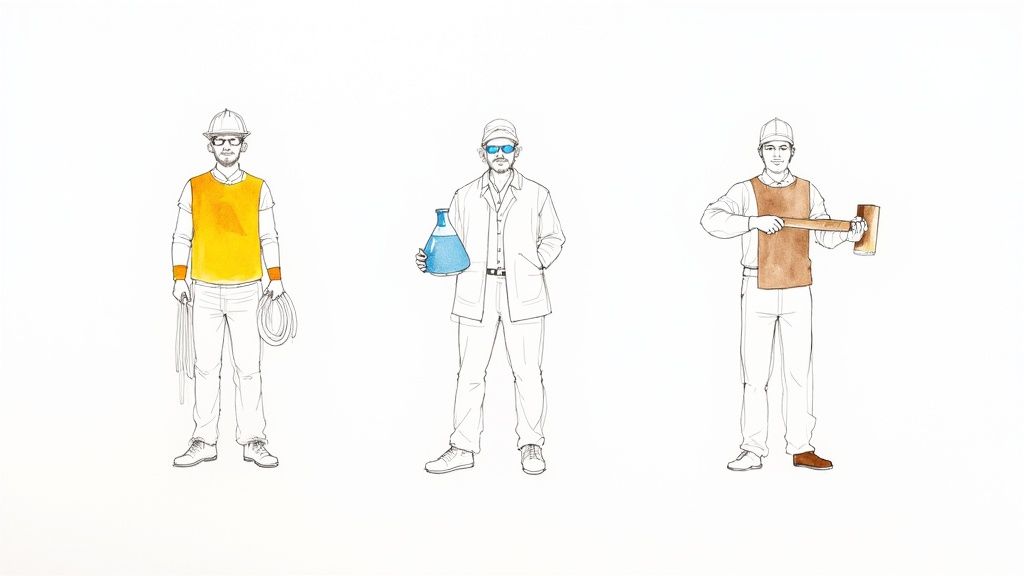
This method is a cornerstone of character design in video games, where roles must be instantly readable. Think of the distinct silhouettes in Team Fortress 2 or the specialized gear of the heroes in Overwatch. Designers like those at Blizzard Entertainment and Valve Corporation excel at this, ensuring that a character's role as a medic, engineer, or soldier is communicated through their appearance alone. The goal is to create a design that tells a story of skill, experience, and daily routine.
How to Implement This Prompt
Choose a profession, whether common or obscure, and dive into research. For this example, let's select a deep-sea welder. Consider the unique demands and environment of this job to inform your visual choices.
- Physique and Posture: A deep-sea welder would likely have a strong, functional build, particularly in the upper body and core, from handling heavy equipment in high-pressure environments. Their posture might be slightly forward-leaning, conditioned by years of focused work in confined spaces.
- Clothing and Gear: Their primary "outfit" is a heavy-duty atmospheric diving suit, covered in scratches and customized with personal touches. You could add specialized tool holsters, reinforced gloves, and a helmet with advanced optics for low-light conditions. For more ideas on how a job defines a character's look, you can find inspiration for outfit ideas on drawinglist.com.
- Accessories and Tools: The iconic tool is the welding torch, but also include grinders, hydraulic shears, and diagnostic equipment. These items should show signs of wear and tear, telling a story of their use.
The final design should feel like a snapshot of a real person shaped by their hazardous profession. Does their face show the stress of the job? Are their non-work clothes practical and simple? These details bring the character to life beyond just their uniform.
Why This Method Works
Grounding a character in a specific occupation provides an instant framework for visual storytelling and authenticity.
- Provides Instant Context: An occupation immediately gives the viewer information about the character's skills, social standing, and potential lifestyle.
- Generates Specific Details: Instead of inventing details from scratch, you can pull from a wealth of real-world information, which adds layers of realism and believability to the design.
- Creates Clear Silhouettes: Professions often come with unique uniforms and equipment, helping you create a distinct and instantly recognizable character silhouette, a key principle in strong character design. A blacksmith, a librarian, and an astronaut will have fundamentally different and readable shapes.
3. Fantasy Race and Species Design
This category of character drawing prompts pushes you beyond human anatomy and into the realm of speculative biology. The goal is to design a character from a non-human species, whether it's a classic fantasy race like an elf or a completely original alien creature. This prompt challenges you to think like a world-builder, considering how environment, culture, and evolutionary pressures would shape a character’s physical form, abilities, and even their society. It's an exercise in creative problem-solving and anatomical invention.
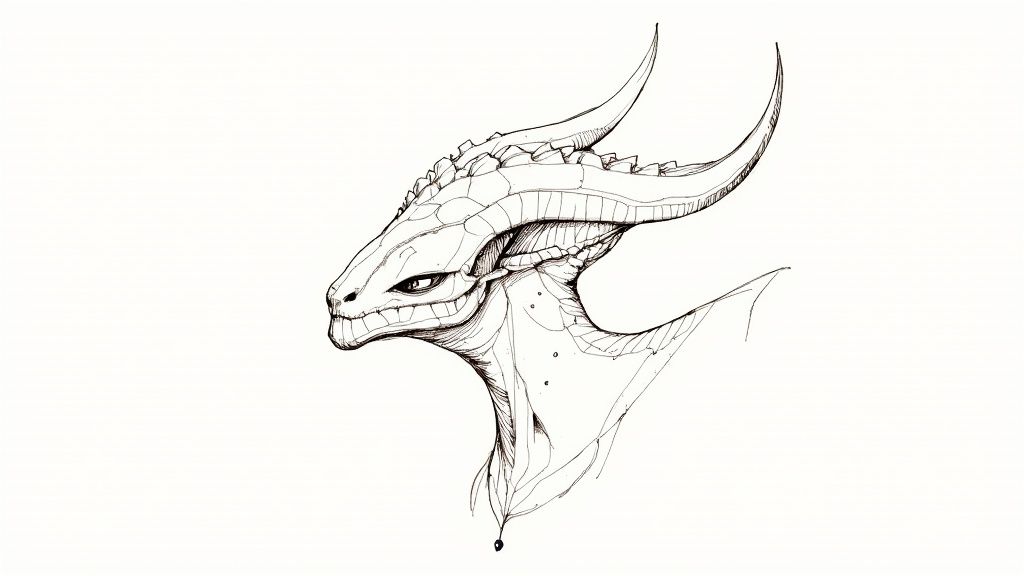
Pioneered by visionaries like H.R. Giger (Alien) and Wayne Barlowe (Avatar), this approach is about creating believable lifeforms. The central task is not just to make something look "cool," but to ensure it possesses an internal logic that makes it feel plausible within its fictional context. Designs like the Na'vi from Avatar or the diverse species in Mass Effect succeed because they feel like the product of a specific world, with adaptations that tell a story about their origins.
How to Implement This Prompt
Start by defining the core environmental conditions of your species' home world. Is it a low-gravity planet, a dense jungle, or an aquatic environment? This will inform your anatomical choices. Let's imagine designing a creature from a windswept, high-altitude mountain region.
- Environmental Adaptation: For a high-altitude habitat, consider features like a barrel chest for larger lung capacity, thick fur or a leathery hide for insulation, and clawed hands or feet for climbing rocky terrain. Their posture might be low to the ground to resist strong winds.
- Sensory Organs: How do they perceive the world? Perhaps they have large, sensitive eyes to see in the thin atmosphere or during frequent cloud cover. Maybe they rely more on hearing or an alternative sense, like echolocation, to navigate treacherous cliffs.
- Cultural Overlays: Once the biology is established, add cultural elements. Do they wear intricate woven gear made from mountain grasses, or do they adorn their bodies with carved stones and minerals found in their environment? Their clothing and tools should reflect their anatomy and lifestyle.
The key is to connect every design choice back to a functional or narrative purpose. A six-limbed creature isn't just visually interesting; it's a logical adaptation for arboreal life. This layered, function-first thinking is what separates a memorable species from a generic monster.
Why This Method Works
Designing non-human characters is an excellent way to break out of artistic ruts and develop a deeper understanding of form and function.
- Expands Anatomical Knowledge: It forces you to study real-world animal anatomy, from insect exoskeletons to avian bone structures, and apply those principles in new ways.
- Strengthens World-Building: A well-designed species makes its world feel more authentic and immersive. The creature's biology becomes a direct form of environmental storytelling.
- Promotes Unconventional Creativity: By removing the constraints of human anatomy, you are free to explore truly unique silhouettes, textures, and body plans, leading to more original and impactful character designs.
4. Historical Period Character Design
This prompt challenges you to act as both an artist and a historian. The goal is to create characters that are authentically rooted in a specific historical period, moving beyond generic costumes to capture the true essence of an era. These types of character drawing prompts require dedicated research into fashion, tools, social customs, and even the common body language of the time. The task is to balance historical accuracy with your own artistic interpretation, ensuring the final character feels like a genuine product of their world.
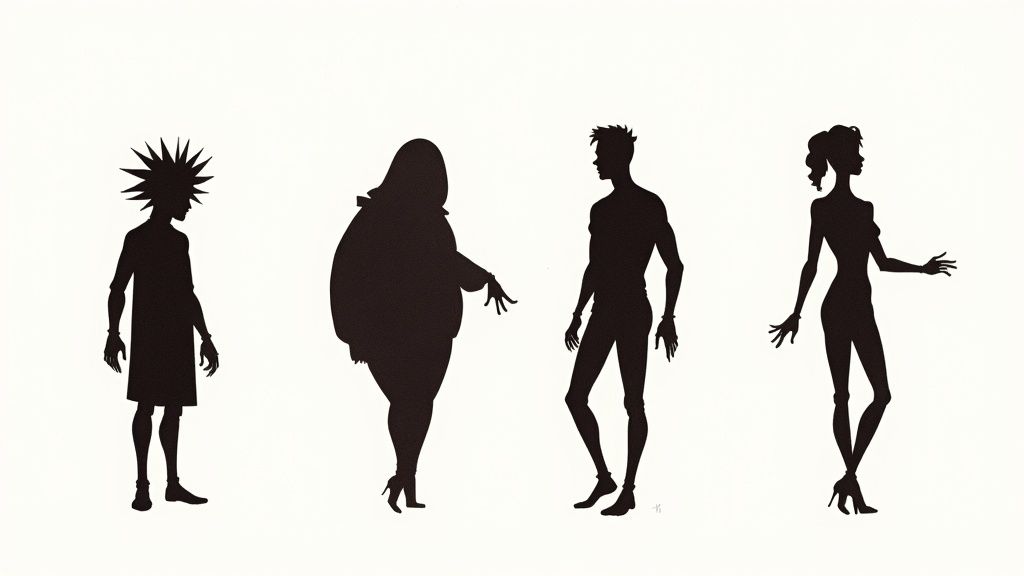
This method develops crucial research skills and cultural awareness, creating visually rich and contextually deep characters. Masterful examples can be seen in the detailed worlds of Ubisoft's Assassin's Creed series or the character-defining outfits in Red Dead Redemption. The work of acclaimed costume designers like Sandy Powell and Colleen Atwood also demonstrates how historical detail can profoundly enhance storytelling, making the past feel tangible and alive.
How to Implement This Prompt
First, choose a specific era and location, for example, a merchant in 17th-century Amsterdam or a samurai in Japan's Edo period. Vague starting points like "the Middle Ages" are too broad; specificity is key to focused research and a believable design.
- Gather Primary and Secondary Sources: Look at paintings, sculptures, and surviving garments from the period (primary sources). Supplement this with information from history books, academic articles, and museum websites (secondary sources).
- Consider Social and Economic Context: A character's social class, profession, and wealth would drastically alter their appearance. A wealthy Victorian lady's dress is vastly different from that of a factory worker. Research these distinctions to add authenticity.
- Focus on the Details: Move beyond the basic silhouette. Investigate hairstyles, accessories, fabrics, and even the way clothes were constructed. How was a garment fastened before zippers? What kind of shoes were practical for the terrain? These small details sell the illusion. For more ideas on setting the stage, you can explore concepts for a historical scene on drawinglist.com.
Why This Method Works
Grounding a character in a historical period offers a powerful framework that can elevate your work from a simple drawing to a piece of visual history.
- Builds Visual Credibility: A well-researched character feels more believable and immersive, immediately establishing the rules and atmosphere of their world for the viewer.
- Provides Rich Narrative Constraints: The limitations of a historical period, such as available technology or social norms, provide a fantastic creative sandbox. These constraints force you to solve design problems in unique and interesting ways.
- Develops Valuable Skills: This process hones your research abilities and attention to detail, skills that are transferable to any world-building or design project, whether it's historical, fantasy, or sci-fi.
5. Emotion and Mood-Based Character Design
This compelling method challenges you to build a character outward from a single, powerful emotional state. Instead of defining a personality, you start with a feeling, like melancholy, euphoria, or dread. These character drawing prompts are exercises in pure visual communication, asking you to make an abstract emotion tangible. Your goal is to create a design where every element, from the droop of an eyelid to the texture of a coat, serves to amplify that core mood and evoke an immediate emotional response from the viewer.
This approach is the secret sauce behind some of animation's most memorable figures, from the expressive casts in Tim Burton's films to the literal embodiments of feeling in Pixar's Inside Out. The challenge isn't just to draw a sad face but to design a character who is sadness. It’s an exploration of how feelings physically manifest, pushing you to master the subtleties of posture, color theory, and environmental storytelling to create a deeply resonant character.
How to Implement This Prompt
Select a specific emotion or mood as your starting point. Let’s work with a complex feeling like serene nostalgia. You will then translate this abstract concept into concrete design choices, building the character's visual identity around it.
- Serene: This aspect calls for soft, flowing lines and a relaxed, stable posture. The character’s expression might be gentle, with half-closed eyes and a soft, slight smile. Their clothing could be loose, made of natural fabrics like linen or soft cotton.
- Nostalgia: Convey this through the color palette and styling. Use warm, slightly faded colors like sepia tones, dusty rose, or pale gold to evoke a sense of the past. The character’s clothing or accessories could be from a bygone era, perhaps well-loved and slightly worn.
- Synthesis: The magic happens when you merge these ideas. Imagine a character in a vintage-style dress, sitting by a window with a peaceful expression, bathed in the warm light of a setting sun. The environment itself, such as a room filled with old photographs or antique furniture, becomes part of the character's emotional expression. Their entire presence should communicate a quiet, pleasant memory.
Why This Method Works
Focusing on a single mood is an incredibly powerful tool for developing your skills in emotional storytelling and creating visually impactful designs.
- Creates Powerful Atmosphere: By dedicating the entire design to one mood, you create a character that instantly sets a tone and atmosphere for any scene they are in.
- Mastery of Subtlety: This prompt forces you to move beyond exaggerated expressions. You learn to communicate deep feeling through nuanced body language, shape language, and the interaction of light and color.
- Strong Visual Identity: Characters born from a specific emotion, like Sadness from Inside Out, are instantly recognizable and memorable because their entire form is a symbol of their core feeling.
6. Silhouette and Shape Language Character Design
This highly effective prompt shifts your focus to a character's most fundamental visual element: their silhouette. Before considering color, texture, or fine details, you concentrate on creating a strong, instantly recognizable shape. This approach is one of the most powerful character drawing prompts for ensuring clarity and impact, as it relies on the principles of shape language, where basic forms like circles, squares, and triangles evoke specific psychological responses. The primary goal is to design a character who is identifiable from their shadow alone.
This method is a cornerstone of character design in animation and video games, seen in the work of studios like Pixar and in games like Overwatch and Team Fortress 2. Each character possesses a unique and exaggerated silhouette that communicates their role, abilities, and personality at a glance. The challenge is to distill a character's essence into a simple, iconic form, ensuring they stand out in a crowd and are memorable to the audience.
How to Implement This Prompt
Begin by thinking exclusively in terms of basic shapes and their associated meanings. Don't draw a character; draw a shape that represents them. Then, build the character within that foundational form.
- Triangles (Dynamic/Dangerous): These shapes suggest aggression, speed, and cunning. Think of villains like Maleficent or fast, agile heroes. Use sharp angles for their shoulders, hairstyles, and accessories to create a sense of threat or forward momentum.
- Circles (Friendly/Approachable): Soft, round shapes convey kindness, innocence, and safety. This is perfect for friendly sidekicks, gentle giants, or child characters. Baymax from Big Hero 6 is a prime example of circular shape language used to create a non-threatening, huggable presence.
- Squares (Stable/Reliable): Squares and rectangles communicate strength, stability, and stubbornness. This shape is ideal for stoic heroes, dependable authority figures, or immovable brutes. Think of characters like The Incredible Hulk or Wreck-It Ralph.
To test your design, fill your character's outline completely with black. Can you still tell who they are? Is their pose and personality clear? If the silhouette is muddled or generic, refine the shapes, exaggerating key features like a unique hairstyle, a large weapon, or distinctive clothing until it becomes iconic. Getting this right is closely tied to their stance; feel free to find additional resources for pose ideas for drawing to strengthen your silhouettes.
Why This Method Works
Focusing on the silhouette first provides a solid foundation that strengthens every other aspect of your character design.
- Creates Instant Readability: A strong silhouette ensures your character is recognizable in any situation, from a fast-paced action scene to a distant establishing shot.
- Communicates Personality Non-Verbally: Shape language is a universal visual shorthand that immediately tells the audience how to feel about a character before they have said or done anything.
- Forces Stronger Posing: Designing for a clear silhouette naturally encourages you to create more dynamic and expressive poses, as a static or stiff pose often results in a boring, unreadable shape.
7. Character Mashup and Fusion Design
This prompt challenges artists to act as creative alchemists, blending disparate elements into a cohesive and original whole. The core task is to take two or more existing characters, concepts, or even species and fuse them, creating something entirely new. These character drawing prompts test your ability to synthesize visual information, maintain design harmony, and solve the complex puzzle of making the unbelievable look believable.
Popularized by everything from the Pokémon fusion fan art community to professional crossover projects like the Street Fighter vs. series, this method is a playground for ingenuity. It forces you to identify the most iconic traits of each source and then decide how they interact, overlap, and merge. The goal is not just to staple parts together, but to imagine a new entity with its own logical anatomy and story, creating a design that is more than the sum of its parts.
How to Implement This Prompt
Begin by selecting two distinct sources to combine. The more unexpected the pairing, the more creative the potential outcome. Let's try to fuse a stoic samurai with a lumbering grizzly bear.
- Samurai: Key elements include the kabuto (helmet), layered do-maru armor, a katana, and a disciplined, upright posture. The aesthetic is one of precision, honor, and sharp, clean lines.
- Grizzly Bear: This source provides powerful, muscular anatomy, thick fur, formidable claws, and a raw, primal energy. Shapes are heavy, rounded, and imposing.
- The Fusion: How do these concepts merge? Imagine a bipedal bear-like creature whose thick fur pokes out from beneath plates of samurai armor. The helmet could be redesigned to fit a bear’s muzzle, and the katana might be larger and heavier to suit its immense strength. Instead of a stoic human face, you have the intense, focused eyes of a bear, conveying a different kind of warrior spirit.
The key is to selectively blend these elements. Perhaps the sleek armor is dented and scratched from a more bestial fighting style. The fusion's narrative is born from these visual choices, telling a story of disciplined training meeting untamed wildness.
Why This Method Works
Fusion design is a fantastic exercise for pushing creative boundaries and developing a keen eye for design principles.
- Breaks Creative Blocks: By providing clear starting points, this prompt removes the pressure of inventing from a blank slate while demanding immense creativity in the execution.
- Develops Design Synthesis: It trains you to analyze what makes a design iconic and how to combine different visual languages into a single, coherent style.
- Generates Unique Concepts: The results are often highly original and memorable, providing standout pieces for a portfolio. A classic example is the work of artists like Alex Ross, whose realistic depictions of superhero mashups give established characters a fresh, powerful context.
8. Environment-Adapted Character Design
This prompt challenges you to think like a world-builder, treating the environment not as a backdrop but as the primary sculptor of your character. The core idea is to design an individual whose appearance, gear, and very biology are a direct response to their surroundings. These powerful character drawing prompts move beyond simple aesthetics, forcing you to consider the practical realities of survival and adaptation in unique or extreme settings, from frozen tundras to volcanic plains or alien jungles.
This method is central to creating believable science fiction and fantasy worlds. Artists like Ralph McQuarrie, who designed characters for Star Wars, and the teams behind games like Horizon Zero Dawn and Dune, excel at this. They ask, "How would a person live here?" and let the answer dictate everything from their body build to the materials used in their clothing, ensuring the design is deeply integrated with its world.
How to Implement This Prompt
First, define a specific, extreme environment. Let's choose a bioluminescent, swampy marshland with a toxic atmosphere. Now, consider how a human or humanoid would adapt to survive and thrive there.
- Physiological Adaptations: What long-term evolutionary changes might occur? Perhaps they have larger nostrils with complex filtering membranes, or even a secondary set of transparent eyelids to protect against airborne toxins. Their skin might be slick and moisture-resistant, like an amphibian's, with a dull, camouflaging color that mimics the murky water and dark flora.
- Clothing and Gear: What resources are available? Their clothing might be woven from fibrous, waterproof reeds or crafted from the durable hides of swamp creatures. They would likely wear a breathing apparatus, perhaps a bio-mechanical filter made from porous coral-like fungi native to the region. Tools could be carved from bone, stone, and the hardened bark of petrified trees.
- Cultural Expression: How does the environment shape their culture and aesthetics? Their jewelry might incorporate glowing moss or polished river stones. Tattoos or body paint could mimic the patterns of local predators for camouflage or spiritual reasons. Their posture might be a permanent crouch, adapted for moving silently through shallow water.
By layering these considerations, you create a character that couldn't exist anywhere else, making your design feel specific, purposeful, and richly imagined.
Why This Method Works
This approach grounds even the most fantastical concepts in a sense of logic and realism, making them more immersive for the viewer.
- Builds Immersive Worlds: A character designed for their environment inherently tells a story about that world, its dangers, and its resources. The Fremen from Dune are a perfect example; their stillsuits and blue-tinted eyes instantly communicate the harsh, arid reality of Arrakis.
- Drives Unique Silhouettes: Practical needs lead to unconventional design choices. A character living in zero gravity will have a completely different silhouette and gear than one who climbs giant crystalline structures, pushing you past generic character shapes.
- Fosters Logical Creativity: It provides a logical framework for your imagination. Instead of just adding "cool" elements, every design choice has a purpose rooted in the world's rules, resulting in a more cohesive and intelligent design.
8 Methods for Character Drawing Prompts Compared
Character Design Approach | Implementation Complexity | Resource Requirements | Expected Outcomes | Ideal Use Cases | Key Advantages |
|---|---|---|---|---|---|
Character Design from Personality Traits | Medium–High | Psychological research, mood boards | Characters visually express personality traits | Character-driven stories, animation | Enhances visual storytelling and character relatability |
Occupation-Based Character Creation | Medium–High | Occupational research, interviews | Realistic, profession-grounded characters | Games, stories requiring realistic roles | Creates believable, culturally rich character designs |
Fantasy Race and Species Design | High | Anatomy/biology study, world-building | Unique non-human characters with believable traits | Fantasy, sci-fi, creature design | Encourages creativity, expands anatomical skills |
Historical Period Character Design | High | Extensive historical research | Accurate period-authentic character designs | Historical fiction, period dramas | Develops research skills and cultural authenticity |
Emotion and Mood-Based Character Design | Medium | Color theory, emotional expression studies | Characters embody clear emotional states | Emotional storytelling, animation | Strengthens emotional communication via visuals |
Silhouette and Shape Language Design | Medium | Focus on shape theory and visual testing | Instantly recognizable, clear character shapes | Animation, comics, quick design prototyping | Enhances design clarity and visual hierarchy |
Character Mashup and Fusion Design | Medium–High | Source material study, style blending skills | Unique, innovative hybrid characters | Creative exercises, crossover designs | Promotes creativity and design synthesis |
Environment-Adapted Character Design | High | Environmental and cultural research | Characters adapted convincingly to their setting | Sci-fi, fantasy, survival stories | Creates grounded, logical character adaptations |
Integrating Prompts into Your Creative Workflow
We've journeyed through a comprehensive arsenal of eight distinct methodologies for breathing life into your character designs. From defining a character through their core Personality Traits to grounding them in a specific Historical Period, each category of prompts offers more than just a fleeting idea. They are structured frameworks designed to ignite your imagination, hone your technical skills, and deepen your storytelling abilities.
The true breakthrough for any artist lies not in finding the single "perfect" prompt, but in understanding how to strategically integrate these methods into a durable, adaptable creative workflow. Think of the prompts we've covered, like Occupation-Based Creation or Fantasy Race Design, as individual tools in your workshop. A hammer is useful on its own, but its power is magnified when used with nails and wood. Similarly, these character drawing prompts achieve their maximum potential when combined and layered.
Building Your Prompt-Driven Process
Moving from simply reacting to a prompt to proactively using it as a problem-solving tool is where your growth will accelerate. The goal is to build a reliable system for generating compelling characters, transforming the unpredictable nature of inspiration into a dependable, repeatable process.
- Start with a Foundation, Then Layer: Begin with a simple, foundational prompt. For example, choose an Emotion-Based Design like "melancholy." Then, layer another prompt on top. How does that melancholy manifest in a character from the Historical Period of the Roaring Twenties? Now, add a third layer: use the Silhouette and Shape Language prompt to translate that "1920s melancholy" into a visual form. Does their silhouette droop with long, sad curves, or is it rigid and brittle? This layering technique creates depth and moves you far beyond a generic sketch.
- Make Prompts a Ritual: Don't wait until you feel uninspired to seek out ideas. Dedicate the first 10-15 minutes of every drawing session to a quick prompt exercise. This practice serves as a creative warm-up, loosening your artistic muscles and preparing your mind for more intensive work. Treat it like a musician running scales; it builds fundamental skills and makes the real performance feel effortless.
- Analyze, Don't Just Draw: When you complete a drawing based on a prompt, take five extra minutes to analyze your work. Ask yourself critical questions. If you used the Environment-Adapted Character prompt for a deep-sea dweller, did you successfully communicate that through their anatomy, gear, and posture? If you tackled a Character Mashup, did you find a clever way to blend the two concepts, or did you just stick them together? This reflective practice turns every drawing, even a "failed" one, into a valuable lesson.
From Practice to Professionalism
Mastering the use of structured character drawing prompts is what separates an artist who waits for inspiration from one who manufactures it on demand. This skill is invaluable, whether you're a hobbyist aiming to fill a sketchbook with memorable faces or a professional concept artist on a tight deadline. It builds creative resilience and confidence. When a client or art director gives you a vague brief, you won't panic. Instead, you'll have a mental toolbox full of frameworks, like Shape Language and Personality-Based Design, to systematically break down the problem and deliver a thoughtful, well-executed solution.
The ultimate benefit is the transformation of your creative process. You move beyond merely drawing what you see to deliberately designing with intent. Your characters will no longer be just a collection of cool features; they will become visual stories, each line and shape contributing to a cohesive and compelling narrative. Your portfolio will reflect this newfound depth, showcasing not just your ability to render, but your ability to think, solve problems, and create truly unforgettable characters. This is the path to developing a unique artistic voice that stands out.
To keep your creative engine running and ensure you never run out of unique combinations, a dedicated tool can be your greatest ally. For a limitless supply of curated and combinable character drawing prompts designed to challenge you, check out the idea generators on Drawing List. It’s the perfect partner for implementing the techniques discussed here and building a consistent, powerful creative habit.
